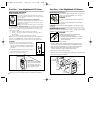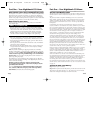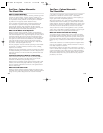
Part Six – Frequently Asked Questions
Q. When I tried to test the alarm I got a high number on the
digital display, but the alarm didn’t sound immediately. Why?
A. Please refer to “How the unit determines when to alarm” on page
5-2 for an explanation of the “time weighted alarm.”
Q. How much electricity does it take to run the CO alarm?
A. The CO alarm uses less than one watt of electricity.
A typical night light uses approximately four watts.
Q. Will the CO alarm last longer if I unplug it during the sum-
mer months and only use it during the winter?
A. No. Some components of the CO alarm can deteriorate over time
if not used regularly. We recommend the CO alarm be plugged in
continuously for maximum alarm life.
Q. I use the CO alarm in a vacation home that isn’t always
occupied and can have temperature extremes when no one is
there (no heat or no air conditioning). Will that hurt the CO
alarm? Should I leave it plugged in all the time?
A. We recommend that your CO alarm not be installed in areas
where temperatures fall below 40˚F (4.4˚C) or rise above 100˚F
(37.8˚C). Your CO alarm was designed to be constantly plugged in
for maximum performance.
Q. I plugged in the CO alarm at my house (my parents’, my
neighbors’, etc.) and it read “0.” Does that mean everything is
OK? (I’m thinking I can return the CO alarm since everything
checks out OK.)
A. This CO alarm is designed to act as a continuous monitor, it is
not designed for use as a short-term testing device to perform a
quick check for the presence of CO.
Remember, a carbon monoxide problem can occur at any time,
even after a professional inspection has determined that everything
is in proper working order. Examples of problems that can develop
are a crack in a furnace heat exchanger, a leak in a water heater
vent, or a bird’s nest blocking a flue.
Other sources are nearly impossible to detect: even a change in the
air pressure outside can turn a normally safe situation deadly. That’s
why you need the 24-hour protection provided by a CO alarm.
Part Six – Frequently Asked Questions
Q. My CO alarm shows a reading of 30 ppm. and then drops
immediately to “0” ppm., what causes this?
A. Per UL2034, (section 3,19) which states “Warning signal: except
for alarm and trouble signals, no other audible and visual signals
shall be used. (ie: warning signals that indicate the presence of CO
less than 30 ppm.)”. Nighthawk CO alarms cannot display CO
concentrations detected below 30 ppm. Under normal conditions,
however by pressing the peak level button, concentrations of CO
detected below 30 ppm will be displayed.
6-4
6-3
810-1009 AC Digital 11/13/01 11:22 AM Page 36


















